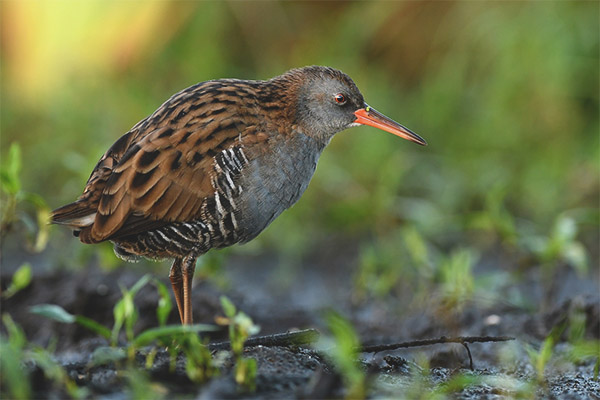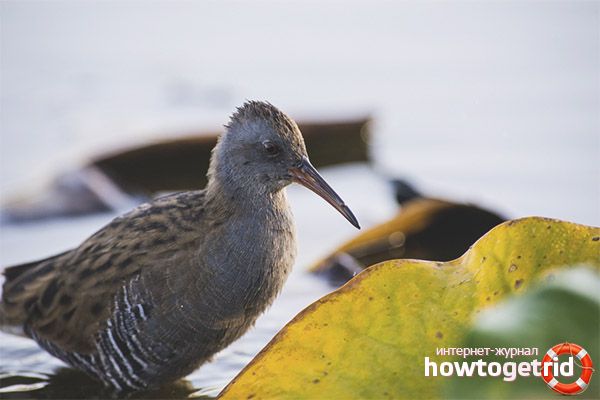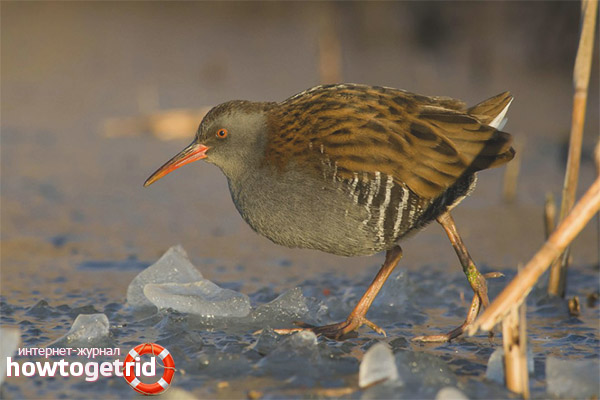The content of the article
Representatives of the family under discussion are otherwise called water shepherds due to the fact that individuals almost always live in swampy areas and near water sources. These birds are protected by the laws of many countries due to the fact that in some regions their population is approaching zero. Today we will study everything that affects the shepherds so that you can form your own opinion about these birds. Let's not delay, let's start right away.
Description
- A shepherd is understood to be a bird belonging to the order crane. She is nocturnal, and also prefers not to appear to the person in the eye. As for the dimensional characteristics, they range from 20 to 25 cm, but in nature there are individuals much smaller than the stated size. By weight birds grow to 0.2 kg.
- As for the general features of the constitution, the bird looks quite dense and weighty. But this is an erroneous phenomenon, since this effect is due to the thick plumage.The body is compressed from the side parts. The head is small in size, the neck is elongated. The bill is long and straight, sharpened on the edge.
- The tail in the form of a wedge rises up. It is medium in length and heterogeneous. The legs are not too long, and the fingers are rather thin and elongated. On paws on 4 fingers, one of which is directed back. Paws clawed and strong.
- By plumage, as mentioned earlier, the birds are thick and fluffy. In the area of the wings, back and tail, olive feathers with brownish tint. There are elongated flecks. The rib cage with the neck and the front part of the head is painted gray with a blue subtone. The side sections of the body have black and white stripes.
- The tail in the inner part is white, the legs and beak are pigmented red. Individuals of male sex are large, females a little less. But in general, birds have no other differences.
Nutrition
- Birds of the species presented most often make up the diet of food of animal origin. They eat spiders, bugs, frogs, small fish, worms, mollusks, insects of different species. But they can diversify the menu with food of plant origin, for example, include seeds of aquatic vegetation in the diet.
- By their natural features, these birds can be ranked as predators.They do not mind eating carrion or stirring a nest with eggs belonging to birds of another family. Almost all food is found on the ground or pulled out of the aquatic environment.
Breeding
- Individuals are ranked as monogamous birds. They find a soul mate for life, after which they are engaged in the continuation of the family, raising children and building a home for the little ones. However, these data are inherent in all members of the squad.
- As for the breeding season, it can fall at different times. It directly depends on the region in which the individuals in question live and live.
- When mating begins, the cowherd boys show unprecedented aggression. They carefully control the territory and ensure that other birds do not climb on it.
- Prefer to build a home for future offspring on the water surface or above the source. All parents are involved in building nests. Reed stems, dry foliage, rogoza, cane, as well as horsetail or sedge act as the basis.
- According to external data, the finished dwelling is somehow reminiscent of a cup, which reaches about 15 cm in diameter, and varies in height from 15 to 20 cm in height.Birds try to carefully camouflage the nest, so that predators do not covet the eggs and chicks. In most cases, the male is engaged in building a nest for himself in order to rest there later.
- Over time, the female can bring a maximum of up to 15 eggs. It is worth noting that adults for a season can bring out two generations. Both parents are engaged in vidding for 20 days. As a result, the young are born already in thick fluff. In this case, the paws and beak are predominantly pink.
- Literally a day later, the chicks are already leaving home, and for some time they follow their parents. Adults feed up young animals. Parents immediately bring food into the open mouth of chicks. Just a week later, the youngsters are trying to independently vyklevyvat food from the ground. After another week, the chicks are already becoming independent.
Habitat
- The individuals under consideration have a rather extensive habitat. Such birds without any problems can be found in North America and Eurasia. Separately, it is worth noting that birds practically do not occur in the northern cold regions.
- The largest number of represented individuals is in the Middle East and Asia. As for the territory of the Russian Federation, birds are mainly found on Lake Ladoga, the Karelian Isthmus, in the Chelyabinsk and Kirov Regions, in Bashkiria.
- Among other things, such birds can be found in Eastern Siberia, Transbaikalia and Sakhalin. The individuals in question prefer a temperate climate. Even if the air temperature drops below 0, the birds are in no hurry to leave their native spaces. The shepherds migrate to warm lands only because of the lack of food at home.
Lifestyle
- Birds try to lead a quiet and rather secretive way of life. The problem is that the individuals are small in size, because of this they simply cannot resist the predators.
- You can notice the birds only by the characteristic singing, which can be heard nearby.
- In the daytime, represented individuals often hide in thick and tall grass. If they are not threatened, they can safely walk in open territory.
The considered birds are characterized by an evening lifestyle. Individuals become most active with the onset of twilight.Often, birds move in quick strides. Only in case of danger, they take off to the side of the meter.
Video: water shepherd (Rallus aquaticus)













To send